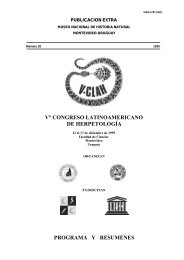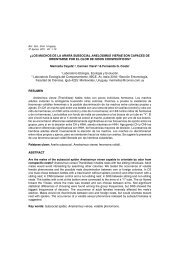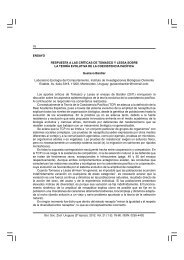Primer Congreso Uruguayo de Zoología - Sociedad Zoológica del ...
Primer Congreso Uruguayo de Zoología - Sociedad Zoológica del ...
Primer Congreso Uruguayo de Zoología - Sociedad Zoológica del ...
Create successful ePaper yourself
Turn your PDF publications into a flip-book with our unique Google optimized e-Paper software.
ETHIC AND WELFARE IN ANIMAL EXPERIMENTATIONArévalo A.P., Schlapp G., Fernán<strong>de</strong>z-Graña G., Goyeneche L. & Crispo M.Unidad <strong>de</strong> Animales Transgénicos y <strong>de</strong> Experimentación (UATE). Institut Pasteur <strong>de</strong> Montevi<strong>de</strong>o. aparevalo@pasteur.edu.uyExperimental animals used in biomedical research are fundamental for medical and scientific advances. There is ahumanitarian concern to <strong>de</strong>velop scientific mo<strong>de</strong>ls of analysis that minimize the use of laboratory animals, although,in some research areas the use of them is still necessary. Successful research <strong>de</strong>pends not only on the correctlyexperimental <strong>de</strong>sign but animal living conditions and human resources. Uruguayan regulations of ethics principles areinclu<strong>de</strong>d in Law Nº 18.611 “UTILIZACIÓN DE ANIMALES EN ACTIVIDADES DE EXPERIMENTACIÓN, DOCENCIA EINVESTIGACIÓN CIENTÍFICA”. Institut Pasteur of Montevi<strong>de</strong>o has an Ethical Committee for Animal Use, whichevaluates the experimental protocols based on this law. In or<strong>de</strong>r to improve animal welfare, UATE is implementingdifferent techniques tending to refine animal experimentation, consi<strong>de</strong>ring refining as those methods that avoid,alleviate or minimize potential pain, stress or distress and improve wellbeing, also showing the benefit of a reductionin the number of animals used. Specific protocols for general animal handling and basic procedures are available forusers, and some protocols are specially <strong>de</strong>signed for a particular research, where the staff and researchers worktogether following the 3 R´s concept (Reduction, Refinement, Replacement). Nowadays, analgesia in differentprocedures, animal enrichment to stimulate natural animal behavior, measure of hormones as physiological welfareindicators of stress in the colony, and human end points are being evaluated. Respecting and working in compliancewith current national and international legislation regarding use and care of experimental animals allows to obtainvalid, reliable, reproducible and comparable results, as well as adopting a responsible attitu<strong>de</strong> from the ethical andmoral point of view for the use of living beings.ESTUDIO COMPARATIVO DE LA ARANEOFAUNA ASOCIADA A CULTIVOS DE ALFALFA YTRIGO DE INVIERNO EN ARGENTINAArmendano A. & González A.Centro <strong>de</strong> Estudios Parasitológicos y <strong>de</strong> Vectores (CEPAVE - CONICET - Universidad Nacional <strong>de</strong> La Plata). La Plata, Argentina.aarmendano@hotmail.comLas arañas presentan un alto grado <strong>de</strong> diversidad en los agroecosistemas, que junto con sus variadas estrategias <strong>de</strong>caza, preferencia <strong>de</strong> hábitats y periodos <strong>de</strong> actividad, logran una gran eficacia para disminuir las poblaciones <strong>de</strong>insectos plaga. A partir <strong>de</strong> muestreos realizados durante tres años consecutivos, con red <strong>de</strong> arrastre y trampas <strong>de</strong>caída, se comparó la comunidad <strong>de</strong> arañas <strong>de</strong> dos cultivos: trigo <strong>de</strong> invierno (Triticum aestivum Linneo) y alfalfa(Medicago sativa Linneo). El número <strong>de</strong> arañas y familias registradas fue mayor en la alfalfa (N= 6229; 15 familias)que en trigo (N= 1701; 13 familias). Thomisidae fue la familia más abundante sobre la vegetación (45,69% trigo y45,80% alfalfa), y Lycosidae (50,42% trigo 42,83% alfalfa) en el suelo. Theridiidae (2,45%) y Actinopodidae (0,4%) seregistraron únicamente en la alfalfa. En el trigo se registraron 7 gremios y en la alfalfa 9, <strong>de</strong>stacándose las cazadoraspor emboscada (Thomisidae), las cazadoras <strong>de</strong> suelo (Lycosidae) y las tejedoras orbiculares (Araneidae). La riquezaespecífica fue mayor en la alfalfa (S=50) que en trigo (S=31), resultando la comunidad <strong>de</strong> alfalfa más diversa y con losmayores valores <strong>de</strong> equidad (alfalfa: H´= 2,97, DMg= 5,61, DSp= 0,11 y J= 0,79; trigo: H´= 1,95, DMg= 4,03, DSp= 0,09y J= 0,69). Ambos cultivos compartieron 31 especies (IMH= 84%, Is= 76%; IJ = 62%). En el estrato herbáceo la especiemás abundante fue Misumenops pallidus (Thomisidae) en los dos cultivos. También se <strong>de</strong>stacaron Araneus sp.1,Metepeira sp., Metazygia sp., Oxyopes salticus y Gayenna sp. (Araneidae, Oxyopidae y Anyphaenidae). En el estrato<strong>de</strong>l suelo <strong>de</strong> ambos cultivos, las especies dominantes fueron Lycosa poliostoma y L. erythrognatha (Lycosidae).Siguieron en abundancia Meioneta sp., Glenognatha lacteovittata y Hahnia sp. (Linyphiidae, Tetragnathidae yHahniidae). La familia con mayor diversidad <strong>de</strong> especies fue Linyphiidae (8 sp. alfalfa/ 4 sp. trigo).144 <strong>Primer</strong> <strong>Congreso</strong> <strong>Uruguayo</strong> <strong>de</strong> <strong>Zoología</strong>







